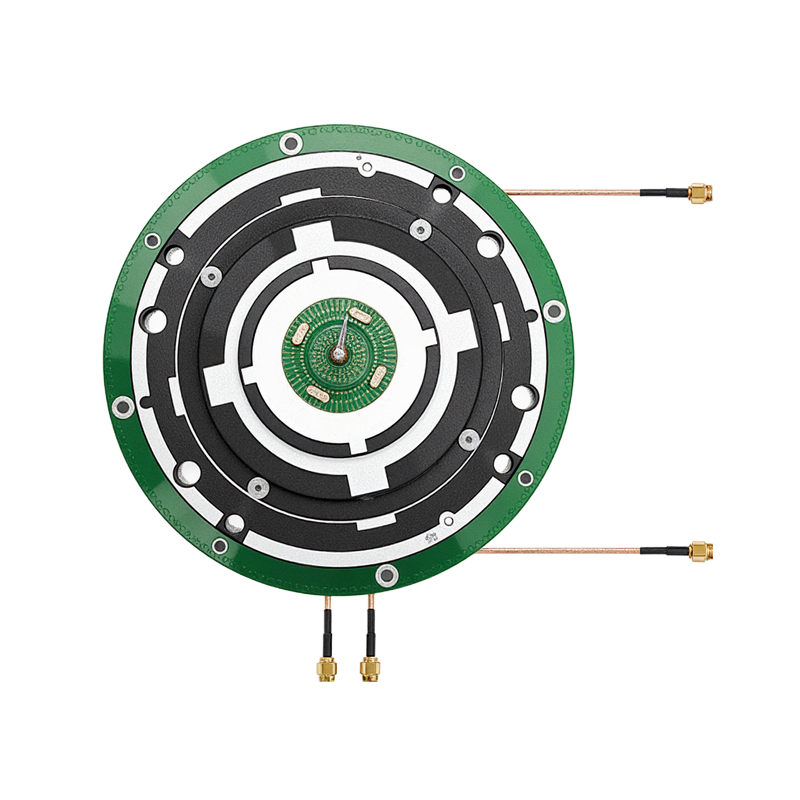
2025-04-23
In the field of GNSS, high-precision antennas are a type of antenna that have special requirements for the stability of the antenna phase center. They are usually used in conjunction with high-precision boards to achieve centimeter or millimeter level high-precision positioning. In the design of high-precision antennas, there are usually special requirements for the following indicators of the antenna: antenna beamwidth, low elevation gain, out of roundness, roll off coefficient, front to back ratio, anti multipath capability, etc. These indicators will directly or indirectly affect the phase center stability of the antenna, thereby affecting the positioning accuracy.
1. Application and classification of high-precision antennas
High precision GNSS antennas were initially mainly used in the field of surveying and mapping, to achieve static millimeter level positioning accuracy in engineering layout, terrain mapping, and various control measurement processes. With the increasing maturity of high-precision positioning technology, high-precision antennas are gradually being applied in more and more fields, including continuous operation reference stations, deformation monitoring, earthquake monitoring, surveying and mapping, unmanned aerial vehicles, precision agriculture, autonomous driving, driving test and training, engineering machinery and other industrial fields. The requirements for antenna indicators also vary significantly in different applications.
1.2 CORS system, deformation monitoring, earthquake monitoring - reference station antenna
When high-precision antennas are applied in continuous operation reference stations, accurate position information is obtained through long-term observation, and the observation data is transmitted in real time to the control center through a data communication system. The control center calculates the error correction parameters in the area and then sends the error information to the mobile station (user end) through ground-based enhancement systems, wide area enhancement systems, satellite based enhancement systems, etc., ultimately enabling users to obtain accurate coordinate information.

In applications such as deformation monitoring and earthquake monitoring, precise monitoring of deformation is required to detect small deformations and predict the occurrence of natural disasters.
Therefore, in the design of high-precision antennas for applications such as continuous operation reference stations, deformation monitoring, and earthquake monitoring, the first consideration must be their excellent phase center stability and resistance to multipath interference, in order to provide real-time accurate position information for various enhanced systems. In addition, in order to provide as many satellite correction parameters as possible, the antenna must receive as many satellites as possible, and the four system full frequency band has become a standard configuration. In such applications, a reference station antenna (reference station antenna) covering the entire frequency band of the four systems is usually used as the observation antenna of the system.
1.3 Measurement and Mapping - Built in Measurement Antenna
In the field of surveying and mapping, it is necessary to design a built-in measurement antenna that is easy to integrate. The antenna is usually built on top of the RTK receiver to achieve real-time high-precision positioning in the field of surveying and mapping.
The main considerations for the design of built-in measurement antennas include frequency band coverage, beam coverage, phase center stability, antenna size, etc. Especially with the popularization of network RTK applications, the full network built-in measurement antennas integrated with 4G, Bluetooth, and WiFi have gradually occupied the main market share. Since their launch in 2016, they have been favored by a large number of RTK receiver manufacturers and have been widely applied and promoted.
1.4 Driving Test and Training, Autonomous Driving - External Measurement Antenna
The traditional driving test system has many drawbacks, such as high investment costs, high operation and maintenance expenses, high environmental impact, and low accuracy. After the application of high-precision antennas in the driving test system, the system has shifted from manual evaluation to intelligent evaluation, with high evaluation accuracy, greatly reducing the labor and material costs of the driving test.
In recent years, unmanned driving systems have developed rapidly. In unmanned driving, RTK high-precision positioning and inertial navigation combined positioning technology are usually used, which can achieve high positioning accuracy in most environments.
In driving test and training, unmanned driving and other systems, external measurement antennas are often used, which require the antenna to have multiple operating frequency bands of multiple systems and frequencies, achieve high positioning accuracy, have certain suppression ability for multipath signals, and have good environmental adaptability. It can be used outdoors for a long time without failure.
1.5 Drone - High precision drone antenna
In recent years, the drone industry has developed rapidly, and drones have been widely used in agricultural crop protection, surveying and mapping, power line patrol and other scenarios. In such scenarios, only with high-precision antennas can the accuracy, efficiency and safety of various operations be guaranteed. Due to the characteristics of fast speed, light load, and short endurance of drones, the design of high-precision antennas for drones mainly focuses on factors such as weight, size, and power consumption, and achieves broadband design as much as possible while ensuring weight and size.